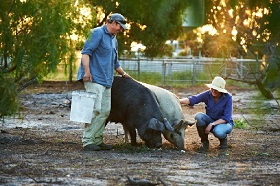When Jamie and Lara McCall followed their dream and moved to the ‘country’, they started a journey that would lead to running a thriving organic farm and farmstay business.
Work timetable
With so much happening on the farm throughout the year, the McCall family have learnt to plan and prioritise their time. All crops and activities are carefully chosen to fit into their schedule so that no part of the farm is neglected and they are not constantly exhausted from trying to achieve too much.
|
Activities conducted on Burnside Organic Farm during the year. |
||||||||||||
|
Activity |
Jan |
Feb |
Mar |
Apr |
May |
Jun |
Jul |
Aug |
Sept |
Oct |
Nov |
Dec |
|
Farm tours |
♦ |
♦ |
♦ |
♦ |
♦ |
♦ |
♦ |
♦ |
♦ |
♦ |
♦ |
♦ |
|
Grow vegetables |
♦ |
♦ |
♦ |
♦ |
♦ |
♦ |
♦ |
♦ |
♦ |
♦ |
♦ |
♦ |
|
Prune grapes |
|
|
|
|
|
♦ |
|
|
|
|
|
|
|
Pick macadamias |
|
|
|
|
|
♦ |
♦ |
♦ |
|
|
|
|
|
Pick avocados |
|
|
|
|
|
|
|
|
♦ |
♦ |
|
|
|
Pick capers |
♦ |
♦ |
|
|
|
|
|
|
|
|
♦ |
♦ |
|
Pick grapes |
|
|
♦ |
♦ |
|
|
|
|
|
|
|
|
|
Make wine |
|
|
♦ |
♦ |
|
|
|
|
|
|
|
|
|
Olives and olive oil |
|
|
|
|
♦ |
|
|
|
|
|
|
|
Diversify your marketing
The McCall’s farmstay business, organic farm and guest farm tours are promoted through their website and Facebook page. All promotional material for Burnside Organic Farm contains very concise descriptions of what is on offer and what is not included.
“We don’t want people to be disappointed. Shopping, hotels and swimming pools are not what we have here. We hope that by warning about the rain in winter and the isolated nature of the farm, that we will only attract the visitors likely to enjoy our farm lifestyle.”
The McCall family also participate in the Margaret River Farmers' Market (MRFM), using it as an outlet for their seasonal supplies of avocados, honey and capers.
“The Margaret River Farmers' Market is a small, organic niche. We sell almost everything we produce. All of the avocados and honey sell at the MRFM and the olive oil and wine is sold to customers who come to the door and the visitors from the bungalows. We sell our wine online from our website along with a good choice of other niche products in small quantities.”

When Lara realised there were people wanting to buy avocados but they were unable to attend the weekend markets, she looked for another solution.
“The farm was not set-up to have a lot of vehicle traffic, so I decided to try a car boot drop-off. People pre-order $10 bags and I meet them at a set time at a central point. Usually there are around 30 people collecting orders and it only takes about 30 minutes. Everyone is happy!”
Owning and running a farmstay can be a great way to mix agriculture and tourism. However before you start, do your research. Define your target audience and design your services, accommodation and activities around their needs and expectations. Also define when and where they would look for your business so that you can develop a marketing strategy that works.
A farmstay can provide a great opportunity to diversify your farm income and indulge in your passion, whether it is meeting new people or educating them on what it means to run a farm or where their food comes from. A farmstay can create a unique agricultural experience for all, just make sure it creates the right experience for you too.
Where to from here
For more information visit Part 1 - farm costs, bungalows and other farm activities.
Acknowledgment: Thanks to our friends at DAFWA - small landholder service for allowing the re-publishing of this article.



